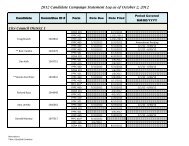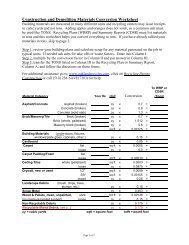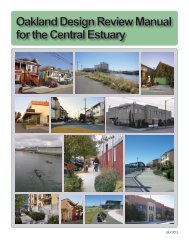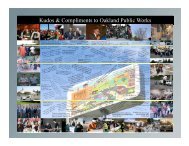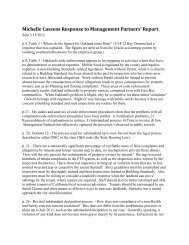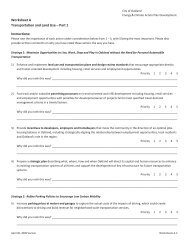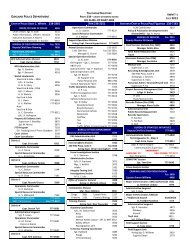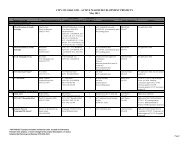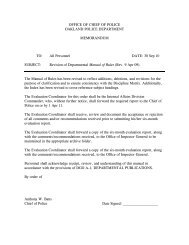Intelligent Transportation Systems - City of Oakland
Intelligent Transportation Systems - City of Oakland
Intelligent Transportation Systems - City of Oakland
You also want an ePaper? Increase the reach of your titles
YUMPU automatically turns print PDFs into web optimized ePapers that Google loves.
6.7.2 Medium-Term Communications Plan (5 to 10 years)<br />
In the medium term, a ring topology backbone should be developed around the <strong>Oakland</strong><br />
CBD connecting all major downtown facilities such as the EOC, TMC and PAB. This<br />
C2C backbone, which may build on the existing downtown fiber loop, will create a highspeed<br />
connection to all <strong>City</strong> agencies and also creates an opportunity for field<br />
communication hubs to connect to remote locations that reach the hubs through TWP<br />
and other low-bandwidth mediums. The backbone will be developed based on the<br />
recommendations <strong>of</strong> the detailed Communications Study performed in the near-term<br />
phase.<br />
The T-1 leased line between the MSY field hub and the <strong>Oakland</strong> TMC should be<br />
discontinued and replaced by a permanent <strong>City</strong>-owned connection. The new connection<br />
will utilize the existing microwave link between 8201 Edgewater and the PAB downtown.<br />
This link will need to be upgraded to a higher bandwidth microwave link and a new fiber<br />
connection will need to be established between the MSY and the 8201 Edgewater<br />
building. From the PAB building, the existing fiber connection to the TMC could be<br />
utilized. However, since the <strong>Transportation</strong> Services Division will only be allocated two<br />
fibers from this connection, the <strong>City</strong> will need to either invest in one <strong>of</strong> the<br />
communications backbone technologies discussed in Section 6.4.1 or install a larger<br />
fiber cable in the existing conduit to complete the TMC to MSY connection.<br />
In addition, a C2C link should be established between the <strong>Oakland</strong> TMC and the Port <strong>of</strong><br />
<strong>Oakland</strong> to enable sharing <strong>of</strong> data and video images. This could be accomplished by<br />
extended the fiber along Hegenberger to the Port <strong>of</strong> <strong>Oakland</strong> TMC located at the<br />
<strong>Oakland</strong> Airport.<br />
Other medium-term projects should include an extension <strong>of</strong> conduits along the major<br />
corridors and installation <strong>of</strong> fiber instead <strong>of</strong> TWP whenever possible.<br />
Public/Private partnerships should be utilized to build additional infrastructure on the<br />
citywide network. An example <strong>of</strong> this type <strong>of</strong> partnership is the agreement currently<br />
being discussed between the <strong>City</strong> <strong>of</strong> <strong>Oakland</strong> and Comcast.<br />
Medium-term projects should also include wireless interconnect to remote locations <strong>of</strong><br />
traffic signal controller cabinets. This wireless connection could utilize SSR or a leased<br />
wireless service.<br />
A schematic diagram <strong>of</strong> the medium-term proposed communications network is depicted<br />
in Figure 6.3.<br />
<strong>City</strong> <strong>of</strong> <strong>Oakland</strong> ITS Strategic Plan<br />
80 September, 2003




